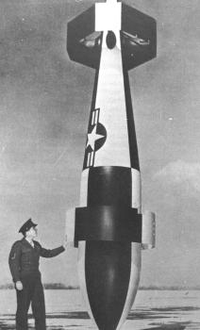GB-4
GB-4 was a precision guided munition developed by the United States during World War II. It was one of the precursors of modern anti-ship missiles.
| GB-4 | |
|---|---|
| Type | anti-ship missile / guided bomb |
| Place of origin | United States |
| Service history | |
| In service | Never used operationally |
| Wars | World War II |
| Specifications | |
| Mass | 2,535 lb (1,150 kg) |
| Length | 12.2 ft (3.7 m) |
| Width | 12 ft (3.7 m) wingspan |
| Diameter | 24 inches (0.61 m) |
| Warhead | amatol explosive |
| Warhead weight | 2,000 lb (910 kg) |
| Engine | none |
Operational range | 17 mi (27 km) |
Guidance system | Television and radio command |
Following German success with the Hs-293 and Fritz-X, the U.S. began developing several similar weapons, such as Felix, Bat, Gargoyle, GB-8, and GB-4.
GB-4's development began in 1944 as a clear-weather, good-visibility weapon to attack heavily defended targets; it was only useful against objectives readily identifiable on the crude CRT screens of the period. It featured a plywood airframe with twin booms and vertical stabilizers, with a horizontal stabilizer and elevator between them. The warhead was a 2,000 pounds (910 kg) general-purpose (GP) bomb.
The target was acquired by a television camera beneath the warhead, with a field of view 18° high and 14° wide, and the bomb was steered by radio command guidance, the operator tracking it by means of flares in the tail. It was intended to be carried externally, under the wing of a Boeing B-17 Flying Fortress or North American B-25 Mitchell. Release was at about 175 miles per hour (280 km/h) and 15,000 feet (4,600 m)) altitude, giving a range of 17 miles (27 km), with an average flight time of four minutes. Its accuracy was 200 feet (61 m).
The Pacific War ended before it entered combat.
A derivative, the GB-9, was intended to use a "dive-and-glide" trajectory for attacking targets like submarine pens from the side, but also did not see combat.
See also
References
Sources
- Fitzsimons, Bernard, ed. (1978). The Illustrated Encyclopedia of 20th Century Weapons and Warfare. 10. London: Phoebus Publishing. p. 1,101.
